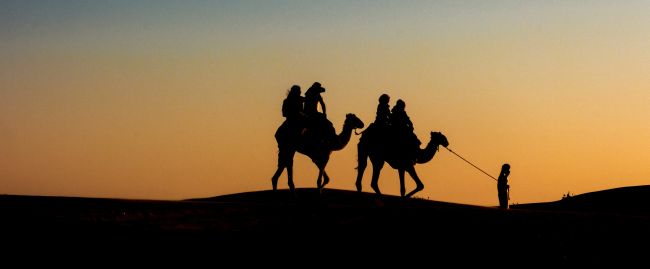
God said to Abram, “Go from your land, your birthplace, and your father’s house . . .” (Berei-shis 12:1)
MOST PEOPLE THOUGHT I was crazy. Only a few said they would join me if they could. As for me, I love travel and adventure, and this was a great opportunity for both. I would do “Lech-Lecha” myself, and retrace the historical and heroic steps our greatest ancestor of all, Avraham Avinu.
After months of research and of saving up money, I set out for Ur Kasdim, the birthplace of Avraham. Easier said than done, because there is no longer any place called “Ur Kasdim.” There is only a lot of discussion from over the ages as to where it might have been.
In 1862, Henry Rawlinson identified Ur Kasdim with Tell el-Muqayyar, near Nasiriyah in southern Iraq. In 1927, Leonard Woolley excavated the site and identified it as a Sumerian archaeological site where the Chaldeans were to settle around the 9th century BCE. Recent archaeology work has continued to focus on the location in Nasiriyah, where the ancient Ziggurat of Ur is located.
According to the Rambam, and before him, the Roman historian Josephus, Ur Kasdim could be located at one of various Upper Mesopotamian or southeast Anatolian sites, such as Urkesh, Urartu, Urfa or Kutha. Not knowing which city for sure, I decided to visit all of them.
Iraq today is not the Mesopotamia of Avraham Avinu’s time, though after thousands of years, there are still many cultural similarities. Even the people living there today may have migrated from other countries over the millennia. It would take a fair bit of imagination to go back in time and try and imagine what it must have been like for Avraham.
According to the Midrash, Avraham Avinu’s father, Terach, was an idol merchant with close connections to the ruler of that time, Nimrod. In those days, EVERYONE believed in idols. This is why it was such a BOLD and DANGEROUS move to disparage them, something Avraham started to do from the tender age of THREE YEARS OLD.
Talk about being mature for one’s age!
Talk about rocking the boat!
Needless to say that Avraham became a very “popular” individual, in a dangerous sort-of-way. When he was older, he mocked the idols and tried to convince people not to buy them. After he destroyed the idols in Nimrod’s own palace, Nimrod had him chained and thrown into a dungeon for 10 years, thinking it would force Avraham to rethink his position.
After the 10 years were over, Nimrod brought Avraham out of jail and demanded that he accept him as a god. Avraham, of course, refused, and was sent to be burned to death instead. Everyone brought wood to contribute to the fire, and 900,000 people came to watch the spectacle, certain that Avraham, only 50 years old at that time, would die that day.
The exact opposite happened. Avraham miraculously survived the fire, and Nimrod was the one who was humbled. A lot of converts were made that day, once Avraham walked away from certain death, totally unscathed. It was all the proof they needed that Avraham’s God was the REAL God, ushering in two years later the “2,000 years of Torah.”
Avraham’s near death told Terach that it was time to leave Ur Kasdim with his family. This made MY next stop what had been THEIR next stop, the city of Charan which, apparently, is thought to be Harran, a city whose ruins lie within present-day Turkey. I even planned to travel part of the route by camel, as they had done.
It was in Charan that Avraham and Sarah, his wife, really stepped up their outreach effort. As the Torah says, they “made” souls there. It is also where Avraham parted ways with his father, after he received the call from God to move on to Eretz Canaan. It was in Charan that Terach died.
As a footnote on history, apparently Terach had done teshuvah for his idol-producing days. You can’t live with a son like Avraham and not wake up to the truth about God along the way. But, I also remembered reading that Terach later reincarnated into Iyov, whose suffering completed whatever teshuvah had been left unfinished when Terach had died.
As I stood where Charan once existed, I tried to imagine Avraham and Sarah teaching the world around them about God, and the major historical revolution it must have started. It changed the way people would think and act forever.
Then came the call: Lech-lecha, but not when many people think it was. Avraham was NOT 70 years old at the time God appeared to him and told him, “Lech-lecha.” He was only 55 years old when God told him, “I am God, Who brought you out from Ur Kasdim . . . Take your wife and all you own and go to Eretz Canaan.”
I followed suit. At the age of 26, I made my own “lech-lecha,” catching a short flight from Istanbul to modern day Eretz Yisroel. I was met at the airport by a guide who came highly recommended to me, both for his knowledge of Tanach and Eretz Yisroel. He liked my idea of retracing the footsteps of the Forefather of the Jewish people.
“So where have you been so far?” he asked me, loading my bags into his trunk. I noted that the car looked pretty new, which meant it probably had good air conditioning. I couldn’t wait to get into the car.
“Ur Kasdim,” I told him, buckling up
“Ur Kasdim?” he asked me, checking his mirror before pulling out. “They actually know where that is?”
“Not for certain,” I told him. “But I had to be in the general area, which was good enough for me.”
“Interesting,” he told me, in Hebrew accented English. “I would like to have been there with you.”
“It was. VERY interesting,” I said. “It’s thousands of years later, yet, somehow, just being there made me feel connected to Avraham and his journey.”
We discussed many of the things I saw and experienced while in Iraq, and how I traveled by camel on my way to Charan. He asked me if I preferred to continue to travel by camel, or to stick with the car. I told him about the old cigarette commercial, in which a guy says he would travel a mile for a camel. I told him, “I just traveled SEVERAL miles ON a camel, and it was enough for me. An air conditioned car suits me just fine for the rest of this journey!”
“The war between Nimrod and Kedarla-omer,” he told me, “took place after Avraham had already been in Eretz Yisroel for 10 years.”
“So, that would have made Avraham . . . 65 years old at the time.”
“Nachon . . .” he confirmed. “When it says, ‘He said to him, “I am God, Who brought you out from Ur Kasdim, to give you this land to inherit it’ . . .”
He quoted the whole verse in Hebrew. I was impressed . . .
(Exerpted from my new book on Sefer Bereishis called, “Insights from the Weekly Torah Reading in Discussion: Volume, Bereishis,” available in Softcover and Kindle through Amazon, and PDF from www.thirtysix.org)


